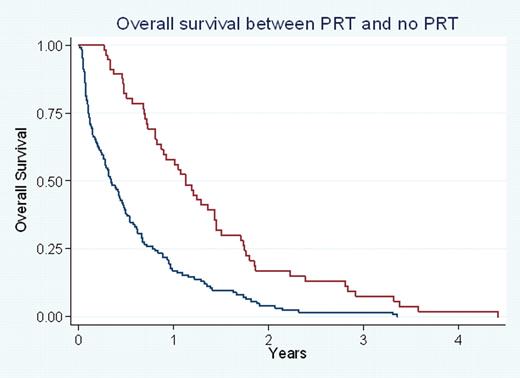Abstract
Abstract 1043
Poster Board I-65
In older (age 3 60) AML patients (pts) who are induced into complete remission, it is unclear whether post-remission therapy provides additional benefit.
We examined all older AML pts treated with cytarabine-based induction chemotherapy at a single institution between 1997 and 2008. Data on known prognostic factors (age, white blood cell count (WBC) at diagnosis, cytogenetic risk groups (as defined by CALGB 8461) and AML etiology (de novo vs. secondary AML)) were collected. Of 240 pts identified, 25 had unknown post-remission status, leaving 215 pts for analyses: 81 receiving cytarabine-based post-remission therapy (PRT) for 1-2 cycles; 134 received no PRT. A cohort study using a propensity score method was conducted in which pts receiving PRT and those not receiving PRT were matched in a 1:1 ratio to address potential sample selection bias and to better balance patient characteristics. A logistic regression was used to predict the propensities of receiving PRT using individual characteristics: age, gender, race, WBC at presentation, AML cytogenetics, secondary AML, re-induction, FAB classification, and complete remission (CR). Overall survival (OS) was measured from the time of diagnosis; disease-free survival (DFS) from the time of CR. Individual characteristics and survival between groups were assessed by the routines of linear, categorical, and survival analyses.
Median age was 68 years (range, 60-81). Patients receiving PRT were more likely to be younger (67 vs 69 years, P=.003), male (67% vs. 52%, p=.04), have de novo AML (75% vs. 50%, p=.0012), favorable- or intermediate-risk cytogenetics (65% vs. 36%, p<.0001), to have M3 AML (5% vs. 0%), and to have achieved a CR (100% vs. 48%, p<.0001). There were no differences between groups in race, WBC at admission, reinduction rates, or comorbid conditions including renal dysfunction, hepatic dysfunction, and cardiac comorbidity. Median DFS and OS for those receiving PRT vs. no PRT were.45 and.34 years, and 1.13 and.69 years (p=.026 and p<.001, respectively, Figure 1). Only 3 patients underwent a bone marrow transplant after relapse, and there was no correlation between the total amount of chemotherapy received during induction for PRT, or OS. After 1:1 propensity score matching (n=88), there were no differences in baseline characteristics, re-induction, or CR rates, yet DFS and OSl remained significantly greater for pts receiving PRT vs. those who did not (Hazard Ratios.48 and.30, p=.05 and p<.0001, respectively).
Even after adjusting for patient disease and treatment factors that could influence PRT administration, older AML pts receiving at least one cycle of PRT lived significantly longer than those who did not. PRT should be considered as a standard part of intensive therapy for older AML pts.
Red line – Patients receiving PRT. Blue line – Patients not receiving PRT
Red line – Patients receiving PRT. Blue line – Patients not receiving PRT
No relevant conflicts of interest to declare.
Author notes
Asterisk with author names denotes non-ASH members.


This feature is available to Subscribers Only
Sign In or Create an Account Close Modal